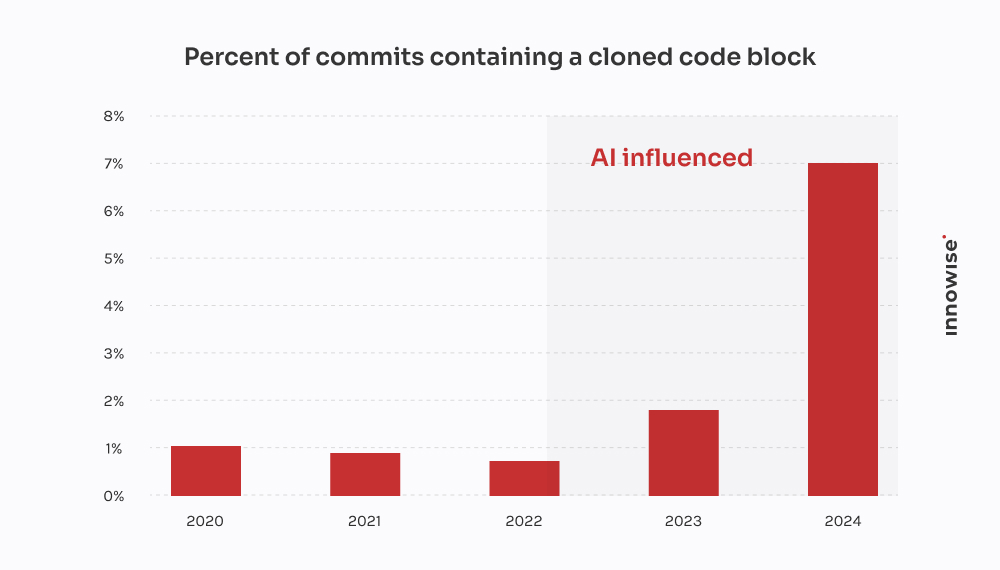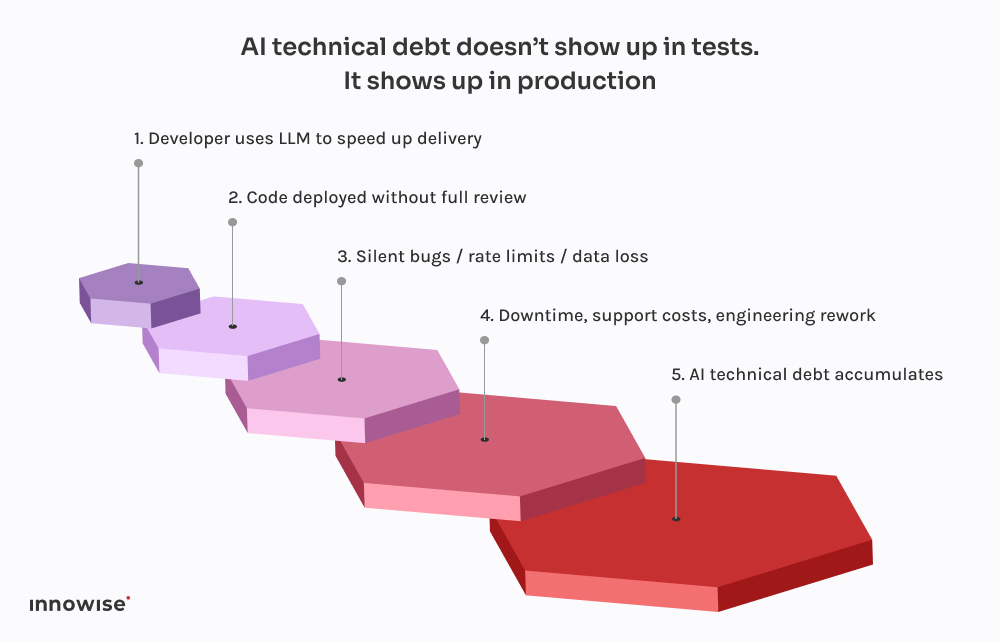Your message has been sent.
We’ll process your request and contact you back as soon as possible.
The form has been successfully submitted.
Please find further information in your mailbox.



As reports from across the industry indicate, there’s now a growing specialized sector for engineers who focus on correcting AI-generated code errors.
The pattern has become remarkably consistent. Companies turn to ChatGPT to generate migration scripts, integrations, or entire features, hoping to save time and cut costs. After all, the technology appears fast and accessible.
Then the systems fail.
And they call us.
Recently, we’ve been getting more and more of these requests. Not to ship a new product, but to untangle whatever mess was left behind after someone trusted a language model with their production code.
At this point, it’s starting to look like its own niche industry. Fixing AI-generated bugs is now a billable service. And in some cases, a very expensive one.
GitClear’s 2024 report confirms what we’ve seen with clients: AI coding tools are speeding up delivery, but also fueling duplication, reducing reuse, and inflating long-term maintenance costs.

Let’s be clear, however, we’re not “against AI.” We use it too. And it’s helpful in the right context, with the right guardrails. But what frustrates me about the overreliance on AI and its widespread implications — and probably you too — is the magical thinking. The idea that a language model can replace real engineering work.
It can’t. And as the saying goes, the proof is in the pudding. When companies pretend otherwise, they end up paying someone like us to clean it up.
So, what does one of these clean-up jobs look like? Here’s what the AI-afficionados aren’t telling you when it comes to time lost and money wasted.
The message usually comes in like this:
“Hey, can you take a look at a microservice we built? We used ChatGPT to generate the first version. We pushed it to staging, and now our RabbitMQ queue is completely flooded.”
But here’s the thing: the symptoms show up much later. Sometimes days later. And when they do, it’s rarely obvious that the root cause was AI-generated code. It just looks like… something’s off.
“You can’t outsource architectural thinking to a language model. AI can speed things up, but it still takes engineers to build systems that don’t fall apart under pressure.”

Chief Technical Officer
After a dozen of these cases, patterns start to emerge:
And of course, when everything collapses, the AI doesn’t leave you a comment saying, “By the way, I’m guessing here.”
That part’s on you.

This one came from a fast-growing fintech company.
They were rolling out a new version of their customer data model, splitting one large JSONB field in Postgres into multiple normalized tables. Pretty standard stuff. But with tight deadlines and not enough hands, one of the developers decided to “speed things up” by asking ChatGPT to generate a migration script.
It looked good on the surface. The script parsed the JSON, extracted contact info, and inserted it into a new user_contacts table.
So they ran it.
No dry run. No backup. Straight into staging, which, as it turns out, was sharing data with production through a replica.
A few hours later, customer support started getting emails. Users weren’t receiving payment notifications. Others had missing phone numbers in their profiles. That’s when they called us.
We traced the issue to the script. It did the basic extraction, but it made three fatal assumptions:
NULL values or missing keys inside the JSON structure.ON CONFLICT DO NOTHING, so any failed inserts were silently ignored.Result: about 18% of the contact data was either lost or corrupted. No logs. No error messages. Just quiet data loss.
We assigned a small team to untangle the mess. Here’s what we did:
Two engineers, three days. Cost to client: around $4,500 in service fees.
But the bigger hit came from customer fallout. Failed notifications led to missed payments and churn. The client told us they spent at least $10,000 on support tickets, SLA compensation, and goodwill credits over that one botched script.
The ironic thing is that a senior developer could’ve written the correct migration in maybe four hours. But the promise of AI speed ended up costing them two weeks of cleanup and reputation damage.
This one came from a legal tech startup building a document management platform for law firms. One of their core features was integrating with a government e-notification service — a third-party REST API with OAuth 2.0 and strict rate limiting: 50 requests per minute, no exceptions.
Instead of assigning the integration to an experienced backend dev, someone on the team decided to “prototype it” using ChatGPT. They dropped in the OpenAPI spec, asked for a Python client, and got a clean-looking script with requests, retry logic using tenacity, and token refresh.
Looked solid on paper. So they shipped it.
Here’s what actually happened:
X-RateLimit-Remaining or Retry-After headers. It just kept sending requests blindly.httpx.AsyncClient, implemented a semaphore-based throttle, added exponential backoff with jitter, and properly handled Retry-After and rate-limit headers.Two engineers, spread over two and a half days. Cost to client: around $3,900.
The bigger problem is that their largest customer — a law firm with time-sensitive filings — missed two court submission windows due to the outage. The client had to do damage control and offer a discount to keep the account.
All because a language model didn’t understand the difference between “working code” and “production-ready code.” And just like that, another layer of AI technical debt was quietly added to the stack.
The scary part isn’t that these things go wrong. It’s how predictable it’s all becoming.
Every one of these incidents follows the same pattern. A developer asks ChatGPT for a code snippet. It returns something that works just well enough not to throw errors. They wire it into the system, maybe clean it up a little, and ship it, assuming that if it compiles and runs, it must be safe.
But here’s the catch: Large language models don’t know your system.
They don’t know how your services interact.
They don’t know your latency budget, your deployment pipeline, your observability setup, or your production traffic patterns.
They generate the most likely-looking code based on patterns in their training data. That’s all. There’s no awareness. No guarantees. No intuition for system design.
And the output often reflects that:
What’s worse is that the code looks correct. It’s syntactically clean. It passes linters. It might even be covered by a basic test. But it’s missing the one thing that actually matters: context.
That’s why these bugs don’t show up right away. They wait for Friday night deployments, for high-traffic windows, for rare edge cases. That’s the nature of AI technical debt – it’s invisible until it breaks something critical.
As we mentioned earlier, we use AI too. Pretty much every engineer on our team has a Copilot-like setup running locally. It’s fast, helpful, and honestly, a great way to skip the boring parts.
But here’s the difference: nothing makes it into the main branch without going through a senior engineer, and in most cases, a CI pipeline that knows what to look for.
LLMs are great at:
What they’re not good at is design. Or context. Or safe defaults.
That’s why we’ve built our workflows to treat LLM output like suggestions, not source of truth. Here’s what that looks like in practice:
Used right, it’s a time-saver. Used blindly, it’s a time bomb.
We’re not here to tell you to ban AI tools. That ship has sailed.
But giving a language model commit access? That’s just asking for trouble.
Here’s what we recommend instead:
Let them help with repetitive code. Let them propose solutions. But don’t trust them with critical decisions. Any code generated by AI should be reviewed by a senior engineer, no exceptions.
Whether it’s commit tags, metadata, or comments in the code, make it clear which parts came from AI. That makes it easier to audit, debug, and understand the risk profile later on.
Decide as a team where it’s acceptable to use LLMs and where it’s not. Boilerplate? Sure. Auth flows? Maybe. Transactional systems? Absolutely not without review. Make the policy explicit and part of your engineering standards.
If you’re letting AI-generated code touch production, you need to assume something will eventually break. Add synthetic checks. Rate-limit monitors. Dependency tracking. Make the invisible visible, especially when the original author isn’t human.
The biggest AI-driven failures we’ve seen didn’t come from “bad” code. They came from silent errors — missing data, broken queues, retry storms — that went undetected for hours. Invest in observability, fallback logic, and rollbacks. Especially if you’re letting ChatGPT write migrations.
In short, AI can save your team time, but it can’t take responsibility.
That’s still a human job.
AI can help you move faster. But it can’t think for you.
It doesn’t understand your architecture. It doesn’t know what “done” means in your context. And it definitely doesn’t care if your data pipeline silently breaks on a Friday night.
That’s why, as CTOs, we need to stay focused on system resilience, not just speed.
It’s tempting to let AI handle the boring parts. And sometimes that’s fine. But every shortcut comes with a tradeoff. When AI-generated code slips through unchecked, it often becomes AI technical debt. The kind you don’t see until your ops team is firefighting in production.
If you’ve already run into that wall, you’re not alone. We’ve helped teams recover from everything from broken migrations to API disasters. We don’t just refactor code. We help refactor the thinking behind it.
Because in the end, that’s what actually makes systems reliable.













Your message has been sent.
We’ll process your request and contact you back as soon as possible.

By signing up you agree to our Privacy Policy, including the use of cookies and transfer of your personal information.